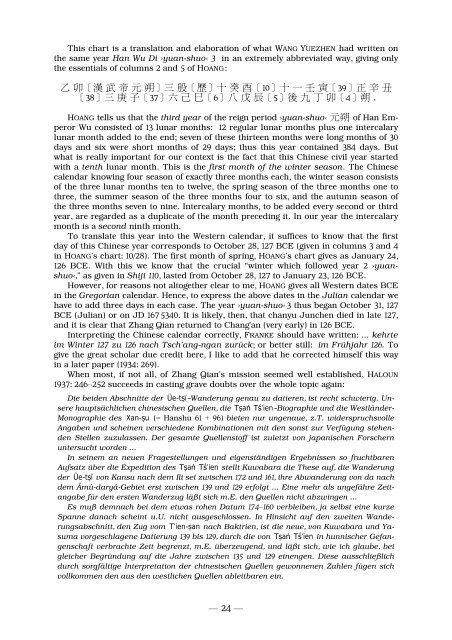張騫 Zhang Qian. The Secret Envoy of Han Emperor Wu in Search of the Arsi (Yuezhi) and the Fall of the Græco-Bactrian Kingdom. (Annotated Compilation of Eastern and Western Sources)
The study undertakes: — to clarify in what year Zhang Qian reached the Oxus river; to establish that the Daxia 大夏 in Shiji 123 represent the Tachar/Tochar of Tochar-i-stan; to explain how we are to understand the "List of Four" in Strabon 11.8.2.
The study undertakes: —
to clarify in what year Zhang Qian reached the Oxus river;
to establish that the Daxia 大夏 in Shiji 123 represent the Tachar/Tochar of Tochar-i-stan;
to explain how we are to understand the "List of Four" in Strabon 11.8.2.
Create successful ePaper yourself
Turn your PDF publications into a flip-book with our unique Google optimized e-Paper software.
This chart is a translation <strong>and</strong> elaboration <strong>of</strong> what WANG YUEZHEN had written on<br />
<strong>the</strong> same year <strong>Han</strong> <strong>Wu</strong> Di ›yuan-shuo‹ 3 <strong>in</strong> an extremely abbreviated way, giv<strong>in</strong>g only<br />
<strong>the</strong> essentials <strong>of</strong> columns 2 <strong>and</strong> 5 <strong>of</strong> HOANG :<br />
乙 卯 [ 漢 武 帝 元 朔 ] 三 殷 [ 歷 ] 十 癸 酉 [10] 十 一 壬 寅 [39] 正 辛 丑<br />
[38] 三 庚 子 [37] 六 己 巳 [6] 八 戊 辰 [5] 後 九 丁 卯 [4] 朔 .<br />
HOANG tells us that <strong>the</strong> third year <strong>of</strong> <strong>the</strong> reign period ›yuan-shuo‹ 元 朔 <strong>of</strong> <strong>Han</strong> Em-<br />
peror <strong>Wu</strong> consisted <strong>of</strong> 13 lunar months: 12 regular lunar months plus on e <strong>in</strong>tercalary<br />
lunar month added to <strong>the</strong> end; seven <strong>of</strong> <strong>the</strong>se thirteen months were long months <strong>of</strong> 30<br />
days <strong>and</strong> six were short months <strong>of</strong> 29 day<br />
s; thus this year conta<strong>in</strong>ed 384 days. But<br />
what is really important for our context is <strong>the</strong> fact that this Ch<strong>in</strong>ese civil year started<br />
with a tenth lunar month. This is <strong>the</strong> first month <strong>of</strong> <strong>the</strong> w<strong>in</strong>ter season. <strong>The</strong> Ch<strong>in</strong>ese<br />
calendar know<strong>in</strong>g four season <strong>of</strong> exactly three months each, <strong>the</strong> w<strong>in</strong>ter season consists<br />
<strong>of</strong> <strong>the</strong> three lunar months ten to twelve, <strong>the</strong> spr<strong>in</strong>g season <strong>of</strong> <strong>the</strong> three months one to<br />
three, <strong>the</strong> summer season <strong>of</strong> <strong>the</strong> three months four to six, <strong>and</strong> <strong>the</strong> autumn season <strong>of</strong><br />
<strong>the</strong> three months seven to n<strong>in</strong>e. Intercalary months, to be added every second or third<br />
year, are regarded as a duplicate <strong>of</strong> <strong>the</strong> month preced<strong>in</strong>g it. In our year <strong>the</strong> <strong>in</strong>tercalary<br />
month is a second n<strong>in</strong>th month.<br />
To translate this year <strong>in</strong>to <strong>the</strong> <strong>Western</strong> calendar, it suffices to know that <strong>the</strong> first<br />
day <strong>of</strong> this Ch<strong>in</strong>ese year corresponds to October 28, 127 BCE (given <strong>in</strong> columns 3 <strong>and</strong> 4<br />
<strong>in</strong> HOANG’s chart: 10/28). <strong>The</strong> first month <strong>of</strong> spr<strong>in</strong>g, HOANG’s chart gives as January 24,<br />
126 BCE. With this we know that <strong>the</strong> crucial “w<strong>in</strong>ter which followed year 2 ›yuanshu<br />
o‹,” as given <strong>in</strong> Shiji 110, lasted from October 28, 127 to January 23, 126 BCE.<br />
However, for reasons not altoge<strong>the</strong>r clear to me, HOANG gives all <strong>Western</strong> dates BCE<br />
<strong>in</strong> <strong>the</strong> Gregorian calendar. Hence, to express <strong>the</strong> above dates <strong>in</strong> <strong>the</strong> Julian calendar we<br />
have to add three days <strong>in</strong> each case. <strong>The</strong> year ›yuan-shuo‹ 3 thus began October 31, 127<br />
BCE (Julian) or on JD 167 5340. It is likely, <strong>the</strong>n, that chanyu Junchen died <strong>in</strong> late 127,<br />
<strong>and</strong> it is clear that <strong>Zhang</strong> <strong>Qian</strong> returned to Chang’an (very early) <strong>in</strong> 126 BCE.<br />
Interpret<strong>in</strong>g <strong>the</strong> Ch<strong>in</strong>ese calendar correctly, FRANKE should have written: ... kehrte<br />
im W<strong>in</strong>ter 127 zu 126 nach Tsch’ang-ngan zurück; or better still: im Frühjahr 126. To<br />
give <strong>the</strong> great scholar due credit here, I like to add that he corrected himself this way<br />
<strong>in</strong> a later paper (1934: 269).<br />
When most, if not all, <strong>of</strong> <strong>Zhang</strong> <strong>Qian</strong>’s mission seemed well established, HALOUN<br />
1937: 246–252 succeeds <strong>in</strong> cast<strong>in</strong>g grave doubts over <strong>the</strong> whole topic aga<strong>in</strong>:<br />
Die beiden Abschnitte der Üe-tṣï–W<strong>and</strong>erung genau zu datieren, ist recht schwierig. Unsere<br />
hauptsächlichen ch<strong>in</strong>esischen Que llen , die Tṣa ṅ Tś’ien–Biographie und die Westländer-<br />
Monographie des Xan-ṣu<br />
(= <strong>Han</strong>s hu 61 + 96) bie ten nur ungenaue, z.T. widerspruchsvolle<br />
Angaben und sche<strong>in</strong>en verschiedene Komb<strong>in</strong>ationen mit den sonst zur Verfügung stehenden<br />
Stellen zuzulassen. Der gesa mte Quellen st<strong>of</strong>f ist zuletzt von japanischen Forschern<br />
untersucht worden ...<br />
In se<strong>in</strong>em an neuen Fragestellungen und eigenständigen Ergebnissen so fruchtbaren<br />
Aufsatz über die Expedition des Tṣaṅ Tś’ien stellt Kuwabara die <strong>The</strong>se auf, die W<strong>and</strong>erung<br />
der Üe-tṣï von Kansu nach dem Ili s ei zwischen 172 und<br />
161, ihre Abw<strong>and</strong>erung von da nach<br />
dem Âmû-daryâ-Gebiet erst zwisch en 139 und<br />
129 erfolgt ... E<strong>in</strong>e mehr als ungefähre Zeitangabe<br />
für den ersten W<strong>and</strong>erzug läßt sich m. E. den Quellen nicht abzw<strong>in</strong>gen ...<br />
Es muß demnach bei dem etwa s rohen Datum 174–160 verbleiben, ja selbst e<strong>in</strong>e kurze<br />
Spanne danach sche<strong>in</strong>t u.U. nicht ausgeschlo ssen. In H<strong>in</strong>sicht auf den zweiten W<strong>and</strong>erungsabschnitt,<br />
den Zug vom T’ien- ṣa n nach Baktrien, ist die n eue, von Kuwabara und Yasuma<br />
vorgeschlagene Datierung 139 b is 129, durch die vo n Tṣaṅ Tś’ien <strong>in</strong> hunnischer Gefangenschaft<br />
verbrachte Zeit be grenzt , m.E. überzeuge nd, und l äßt sich, wie ich glaube, bei<br />
gleicher Begründung auf die Jahre zwischen<br />
135 und 129 e<strong>in</strong>engen. Diese ausschließlich<br />
durch sorgfältige Interpretation der ch<strong>in</strong>esischen Quellen gewonnenen Zahlen fügen sich<br />
vollkommen den aus den westlichen Quellen ableitbaren e<strong>in</strong>.<br />
— 24 —


